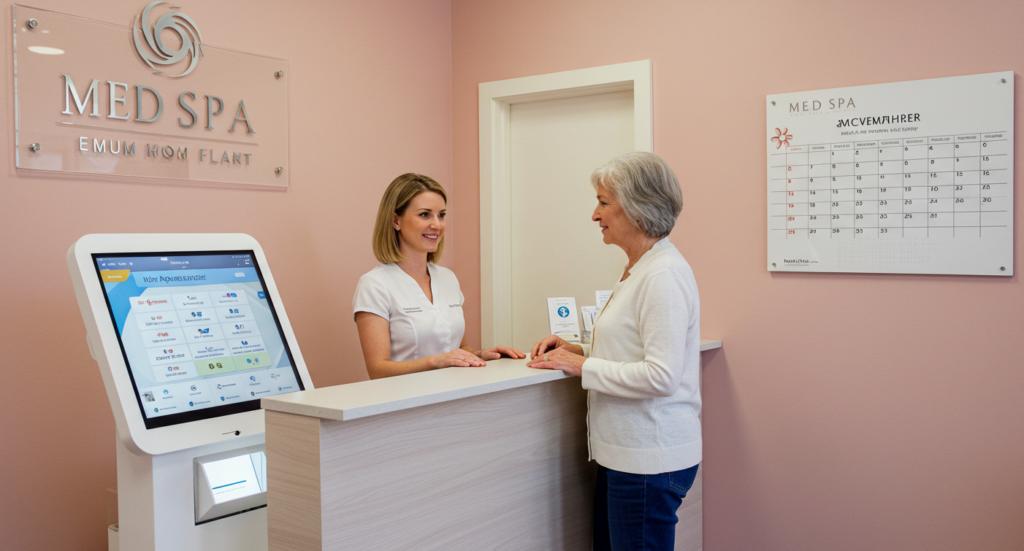Picture this: it’s Monday morning, and you’re looking at next week’s schedule. Half the appointment slots are empty. Your team is getting paid to wait around, and you’re wondering if you should pump more money into Facebook ads or invest in better med spa SEO strategies.
Sound familiar? You’re not alone. This frustrating cycle happens to med spa owners everywhere, from brand-new practices to well-established clinics. But here’s what might surprise you – the solution probably isn’t what you think it is.
Why More Marketing Won’t Save Your Empty Schedule
Most med spa owners believe empty calendars mean they need more new patients. So they spend thousands on digital marketing, run special promotions, and chase the latest social media trends. While implementing proven med spa marketing strategies is important, this approach alone creates an expensive problem.
When you constantly chase new patients without focusing on keeping existing ones, you end up on what industry expert Katlin Cauffman calls “that hamster wheel where you’re turning and burning through new patients.”
This cycle drains your marketing budget and keeps you stressed about next month’s bookings. There’s a better way.
The Simple Strategy That Actually Works
After helping hundreds of med spas across the country, Cauffman discovered something interesting. The practices with consistently full schedules weren’t necessarily the ones with the biggest marketing budgets. They were the ones doing one thing differently: tracking their rebooking rates.
"The number one key to filling up your schedule is this very simple thing: tracking your rebooking rates and having a rebooking culture in your Med Spa," Katlin explains.

Think about it this way. Getting an 80% rebooking rate will fill your schedule faster than bringing in 25 new patients per month with only a 30% rebooking rate. The math is simple, but most med spas never run these numbers.
What Most Med Spas Get Wrong
Here’s the uncomfortable truth: if you’re not tracking rebooking rates, you’re probably only rebooking 20-50% of your patients. That means half or more of your patients leave without their next appointment scheduled.
Many practices fall into these common traps:
- The assumption trap: Providers assume their favorite patients will call when they’re ready
- Vague language: Front desk staff say things like “just give us a call when you want to come back”
- No systematic approach: There’s no consistent process for scheduling follow-up appointments
- Lack of accountability: Nobody tracks whether patients actually rebook before leaving
Meanwhile, patients get busy with life. Weeks turn into months. They might see a competitor’s promotion on social media, or simply forget about their treatment plan altogether. Before you know it, you’ve lost them.
How to Book More Appointments as a Med Spa: Track Your Success
The good news? Fixing this doesn’t require expensive software or complicated medical spa online scheduling systems. You just need to start measuring what matters.
Here’s the simple weekly tracking process:
Step 1: Pull the list of patients who had appointments last week
Step 2: Go through each appointment and check if they scheduled their next visit before leaving
Step 3: Track results by individual provider and team overall
Step 4: Share results with your team weekly
Some EMR systems can automate this tracking, but many don’t. If you need to do it manually, it takes maybe 10 minutes per week – even for larger teams. The return on this small time investment is huge.
Here’s what happens next: when you start sharing these numbers with your team, everything changes. Providers become more aware of their checkout conversations. Front desk staff pay attention to how they schedule follow-ups.
"You are going to see an increase of 10 to 20% in the rebooking rate just because you are tracking it," notes Cauffman.
This improvement happens without changing anything else – just by measuring and sharing the results.
The Real-World Impact on Your Revenue
Let’s do some simple math to show why this matters so much. Say you see 10 patients per week and currently rebook 50% of them. If you improve to 70% rebooking, that’s 2 extra appointments per day, 10 per week, and 40 additional bookings per month.
Now multiply that across your entire team. If you have five providers, that’s potentially 200 extra appointments per month – just from improving rebooking rates. Each of those appointments represents revenue you’re currently leaving on the table.
The benefits go beyond just numbers:
- Better patient outcomes: Consistent treatments lead to superior results
- Higher provider commissions: More appointments mean more earnings for your team
- Increased patient satisfaction: Regular care builds stronger relationships
- Predictable revenue: You can forecast income more accurately
This approach works especially well when combined with effective medical spa pricing strategies that encourage ongoing treatment plans.
Building a Culture That Books More Appointments
Creating lasting change means making rebooking part of your normal routine. Start by setting clear expectations with your team. Make 80% rebooking your target goal and talk about it in team meetings.
Train your staff on better checkout language:
Instead of saying: “Call us when you’re ready”
Try saying: “Based on your treatment plan, let’s get your next appointment scheduled for 4-6 weeks from now”
Instead of saying: “We’ll see you soon”
Try saying: “Your results will be even better with consistent treatments, so let’s book your follow-up now”
Consider rewarding team members who consistently hit rebooking targets. Recognition and small bonuses can motivate everyone to pay more attention to this crucial part of the patient experience. This ties directly into building top injectors for your med spa who understand the importance of patient retention.
“Empty schedules are a symptom—lack of rebooking culture is the disease. Treat it at the source.” — Katlin Cauffman

Beyond the Initial Appointment
Smart medical spa scheduling systems don’t end when patients leave. Even with great rebooking habits, some people won’t schedule immediately. That’s why successful practices have backup systems for how to book more appointments as a med spa consistently.
Your follow-up strategy should include:
- Two-week follow-up calls for patients who didn’t rebook initially
- Reactivation campaigns using email marketing strategies for patients who haven’t been seen in months
- Annual appointment scheduling even for patients who only visit once yearly
- SMS reminders using med spa SMS marketing best practices to stay top-of-mind
As Cauffman points out, "even if they only come in once a year, you still want to rebook them for that annual appointment"
Why This Strategy Beats Expensive Marketing
When you focus on rebooking existing patients, you’re working with people who already know and trust you. They’ve experienced your results and understand your value. Converting them is much easier than convincing complete strangers to try your services.
This doesn’t mean you should stop med spa lead generation entirely. New patient acquisition remains important for growth. But when you master rebooking, you reduce your dependence on expensive marketing channels. Your schedule stays full with less stress and lower costs.
The key is creating a comprehensive approach that includes:
- Strong rebooking processes (your foundation)
- Effective social media marketing for brand awareness
- SEO-optimized website design for organic traffic
- Strategic promotions and retail sales to increase visit frequency
Getting Started This Week
The beauty of this approach is its simplicity. You don’t need new technology, extensive training, or a big budget. You just need to start tracking and create accountability around rebooking.
"I need you to drink the Kool-Aid when it comes to rebooking," urges Cauffman.
She’s right – this mindset shift can transform your entire practice.
Your action plan for this week:
- Start tracking this week’s appointments and see how many patients left with their next visit scheduled
- Share the results with your team and set improvement goals
- Train your front desk on better scheduling language during checkout
- Set rebooking targets for each provider (aim for 80% as your goal)
- Create accountability by reviewing numbers weekly in team meetings
Within a month, you’ll likely see noticeable changes in your booking patterns. The practices that master this strategy don’t worry about empty schedules. They have predictable revenue, happier staff, and better patient outcomes.
Most importantly, they spend less time and money chasing new patients because they’re excellent at keeping the ones they have. When you keep your Botox patients coming back consistently, your entire business model becomes more profitable and sustainable.
Your medical spa schedule doesn’t have to be a constant source of stress. With the right focus on rebooking, you can build the consistent, profitable practice you’ve always wanted.
Transform Your Medical Spa Scheduling Today
Ready to stop the feast-or-famine cycle and build a consistently booked practice? The strategies that separate successful med spas from struggling ones are simpler than you think – but they require the right implementation.
Don’t spend another month watching empty appointment slots while your competitors thrive. Schedule your complimentary strategy session now and discover exactly how to implement these proven systems in your med spa.
Your future success starts with one decision today.


